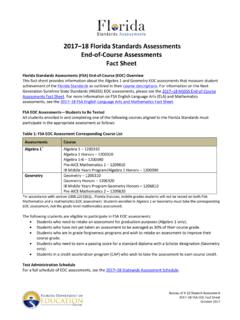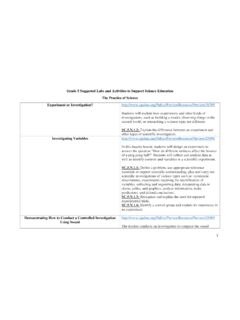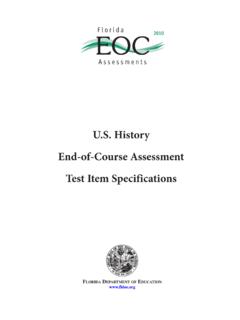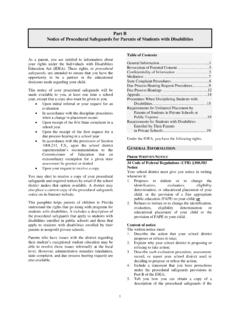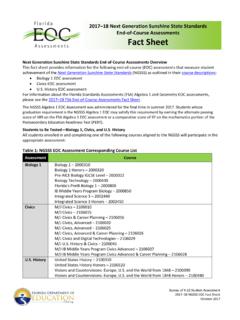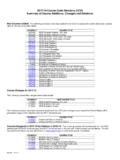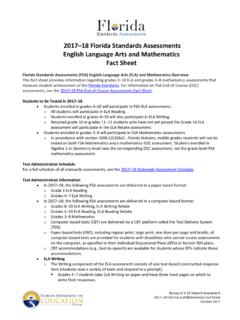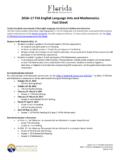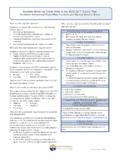Transcription of Language Arts Florida Standards (LAFS) Grades 11 & 12
1 | #FLStandards 2014, Florida Department of Education. All Rights Reserved. Language Arts Florida Standards ( lafs ) Grades 11 & 12 Strand: READING Standards FOR LITERATURE Cluster 1: Key Ideas and Details STANDARD CODE STANDARD Cite strong and thorough textual evidence to support analysis of what the text says explicitly as well as inferences drawn from the text, including determining where the text leaves matters uncertain. Cognitive Complexity: Level 3: Strategic Thinking & Complex Reasoning Determine two or more themes or central ideas of a text and analyze their development over the course of the text, including how they interact and build on one another to produce a complex account; provide an objective summary of the text. Cognitive Complexity: Level 3: Strategic Thinking & Complex Reasoning Analyze the impact of the author s choices regarding how to develop and relate elements of a story or drama ( , where a story is set, how the action is ordered, how the characters are introduced and developed).
2 Cognitive Complexity: Level 3: Strategic Thinking & Complex Reasoning Cluster 2: Craft and Structure STANDARD CODE STANDARD Determine the meaning of words and phrases as they are used in the text, including figurative and connotative meanings; analyze the impact of specific word choices on meaning and tone, including words with multiple meanings or Language that is particularly fresh, engaging, or beautiful. (Include Shakespeare as well as other authors.) Cognitive Complexity: Level 3: Strategic Thinking & Complex Reasoning Analyze how an author s choices concerning how to structure specific parts of a text ( , the choice of where to begin or end a story, the choice to provide a comedic or tragic resolution) contribute to its overall structure and meaning as well as its aesthetic impact. Cognitive Complexity: Level 3: Strategic Thinking & Complex Reasoning Analyze a case in which grasping a point of view requires distinguishing what is directly stated in a text from what is really meant ( , satire, sarcasm, irony, or understatement).
3 Cognitive Complexity: Level 3: Strategic Thinking & Complex Reasoning | #FLStandards 2014, Florida Department of Education. All Rights Reserved. Cluster 3: Integration of Knowledge and Ideas STANDARD CODE STANDARD Analyze multiple interpretations of a story, drama, or poem ( , recorded or live production of a play or recorded novel or poetry), evaluating how each version interprets the source text. (Include at least one play by Shakespeare and one play by an American dramatist.) Cognitive Complexity: Level 3: Strategic Thinking & Complex Reasoning Demonstrate knowledge of eighteenth-, nineteenth- and early-twentieth-century foundational works of American literature, including how two or more texts from the same period treat similar themes or topics. Cognitive Complexity: Level 3: Strategic Thinking & Complex Reasoning Cluster 4: Range of Reading and Level of Text Complexity STANDARD CODE STANDARD By the end of grade 11, read and comprehend literature, including stories, dramas, and poems, in the Grades 11 CCR text complexity band proficiently, with scaffolding as needed at the high end of the range.
4 By the end of grade 12, read and comprehend literature, including stories, dramas, and poems, at the high end of the Grades 11-CCR text complexity band independently and proficiently. Cognitive Complexity: Level 2: Basic Application of Skills & Concepts Strand: READING Standards FOR INFORMATIONAL TEXT Cluster 1: Key Ideas and Details STANDARD CODE STANDARD Cite strong and thorough textual evidence to support analysis of what the text says explicitly as well as inferences drawn from the text, including determining where the text leaves matters uncertain. Cognitive Complexity: Level 3: Strategic Thinking & Complex Reasoning Determine two or more central ideas of a text and analyze their development over the course of the text, including how they interact and build on one another to provide a complex analysis; provide an objective summary of the text.
5 Cognitive Complexity: Level 3: Strategic Thinking & Complex Reasoning Analyze a complex set of ideas or sequence of events and explain how specific individuals, ideas, or events interact and develop over the course of the text. Cognitive Complexity: Level 3: Strategic Thinking & Complex Reasoning | #FLStandards 2014, Florida Department of Education. All Rights Reserved. Cluster 2: Craft and Structure STANDARD CODE STANDARD Determine the meaning of words and phrases as they are used in a text, including figurative, connotative, and technical meanings; analyze how an author uses and refines the meaning of a key term or terms over the course of a text ( , how Madison defines faction in Federalist No. 10). Cognitive Complexity: Level 3: Strategic Thinking & Complex Reasoning Analyze and evaluate the effectiveness of the structure an author uses in his or her exposition or argument, including whether the structure makes points clear, convincing, and engaging.
6 Cognitive Complexity: Level 3: Strategic Thinking & Complex Reasoning Determine an author s point of view or purpose in a text in which the rhetoric is particularly effective, analyzing how style and content contribute to the power, persuasiveness or beauty of the text. Cognitive Complexity: Level 3: Strategic Thinking & Complex Reasoning Cluster 3: Integration of Knowledge and Ideas STANDARD CODE STANDARD Integrate and evaluate multiple sources of information presented in different media or formats ( , visually, quantitatively) as well as in words in order to address a question or solve a problem. Cognitive Complexity: Level 3: Strategic Thinking & Complex Reasoning Delineate and evaluate the reasoning in seminal texts, including the application of constitutional principles and use of legal reasoning ( , in Supreme Court majority opinions and dissents) and the premises, purposes, and arguments in works of public advocacy ( , The Federalist, presidential addresses).
7 Cognitive Complexity: Level 3: Strategic Thinking & Complex Reasoning Analyze seventeenth-, eighteenth-, and nineteenth-century foundational documents of historical and literary significance (including The Declaration of Independence, the Preamble to the Constitution, the Bill of Rights, and Lincoln s Second Inaugural Address) for their themes, purposes, and rhetorical features. Cognitive Complexity: Level 3: Strategic Thinking & Complex Reasoning | #FLStandards 2014, Florida Department of Education. All Rights Reserved. Cluster 4: Range of Reading and Level of Text Complexity STANDARD CODE STANDARD By the end of grade 11, read and comprehend literary nonfiction in the Grades 11 CCR text complexity band proficiently, with scaffolding as needed at the high end of the range. By the end of grade 12, read and comprehend literary nonfiction at the high end of the Grades 11 CCR text complexity band independently and proficiently.
8 Cognitive Complexity: Level 2: Basic Application of Skills & Concepts Strand: WRITING Standards Cluster 1: Text Types and Purposes STANDARD CODE STANDARD Write arguments to support claims in an analysis of substantive topics or texts, using valid reasoning and relevant and sufficient evidence. a. Introduce precise, knowledgeable claim(s), establish the significance of the claim(s), distinguish the claim(s) from alternate or opposing claims, and create an organization that logically sequences claim(s), counterclaims, reasons, and evidence. b. Develop claim(s) and counterclaims fairly and thoroughly, supplying the most relevant evidence for each while pointing out the strengths and limitations of both in a manner that anticipates the audience s knowledge level, concerns, values, and possible biases. c. Use words, phrases, and clauses as well as varied syntax to link the major sections of the text, create cohesion, and clarify the relationships between claim(s) and reasons, between reasons and evidence, and between claim(s) and counterclaims.
9 D. Establish and maintain a formal style and objective tone while attending to the norms and conventions of the discipline in which they are writing. e. Provide a concluding statement or section that follows from and supports the argument presented. Cognitive Complexity: Level 4: Extended Thinking &Complex Reasoning Write informative/explanatory texts to examine and convey complex ideas, concepts, and information clearly and accurately through the effective selection, organization, and analysis of content. a. Introduce a topic; organize complex ideas, concepts, and information so that each new element builds on that which precedes it to create a unified whole; include formatting ( , headings), graphics ( , figures, tables), and multimedia when useful to aiding comprehension. | #FLStandards 2014, Florida Department of Education.
10 All Rights Reserved. b. Develop the topic thoroughly by selecting the most significant and relevant facts, extended definitions, concrete details, quotations, or other information and examples appropriate to the audience s knowledge of the topic. c. Use appropriate and varied transitions and syntax to link the major sections of the text, create cohesion, and clarify the relationships among complex ideas and concepts. d. Use precise Language , domain-specific vocabulary, and techniques such as metaphor, simile, and analogy to manage the complexity of the topic. e. Establish and maintain a formal style and objective tone while attending to the norms and conventions of the discipline in which they are writing. f. Provide a concluding statement or section that follows from and supports the information or explanation presented ( , articulating implications or the significance of the topic).
